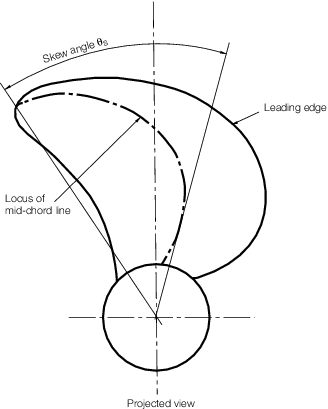
Section
1 Plans and particulars

1.1 Details to be submitted
1.1.1 A plan,
in triplicate, of the propeller is to be submitted for approval, together
with the following particulars using the symbols shown:
-
Maximum blade thickness
of the expanded cylindrical section considered, T, in
mm.
-
Maximum shaft power
(see
Pt 5, Ch 1, 3.3 Power ratings), P,
in kW.
-
Estimated ship speed
at design loaded draught in the free running condition at maximum
shaft power and corresponding revolutions per minute (see (Pt 5, Ch 5, 1.1 Details to be submitted 1.1.1.(b)) and (Pt 5, Ch 5, 1.1 Details to be submitted 1.1.1.(d))).
-
Revolutions per minute
of the propeller at maximum power, R.
-
Propeller diameter, D, in metres.
-
Pitch at 25 per cent
radius (for solid propellers only), P
0,25,
in metres.
-
Pitch at 35 per cent
radius (for controllable pitch propellers only), P
0,35,
in metres.
-
Pitch at 60 per cent
radius P
0,6, in metres
-
Pitch at 70 per cent
radius P
0,7, in metres
-
Length of blade section
of the expanded cylindrical section at 25 per cent radius ( for solid
propellers only), L
0,25, in mm.
-
Length of blade section
of the expanded cylindrical section at 35 per cent radius (for controllable
pitch propellers only) L
0,35, in mm.
-
Length of blade section
of the expanded cylindrical section at 60 per cent radius, L
0,6, in mm.
-
Rake at blade tip
measured at shaft axis (backward rake positive, forward rake negative), A, in mm.
-
Number of blades, N.
-
Developed area ratio, B.
-
Material: type and
specified minimum tensile strength.
-
θs,
skew angle, in degrees, (see
Figure 5.1.1 Definition of skew angle).
-
Connection of propeller
to shaft – details of fit, push-up, securing, etc.

Figure 5.1.1 Definition of skew angle
1.1.2 For propellers
having a skew angle equal to or greater than 50°, in addition
to the particulars detailed in Pt 5, Ch 5, 1.1 Details to be submitted 1.1.1 details
are to be submitted of:
-
Full blade section
details at each radial station defined for manufacture.
-
A detailed blade
stress computation supported by the following hydrodynamic data for
the ahead mean wake condition and when absorbing full power:
-
Radial distribution
of lift and drag coefficients, section inflow velocities and hydrodynamic
pitch angles.
-
Section pressure
distributions calculated by either an advised inviscid or viscous
procedure.
1.1.3 For blades
of fixed pitch propellers with skew angle of 30° or greater, the
stresses in the propeller blade during astern operation are not to
exceed 80 per cent of the propeller blade material proof stress. Consideration
is to be given to failure conditions and a factor of safety of 1,5
is to be attained using an acceptable fatigue failure criteria. Documentary
evidence confirming that these criteria are satisfied is to be submitted.
1.1.4 The maximum
skew angle of a propeller blade is defined as the angle, in projected
view of the blade, between a line drawn through the blade tip and
the shaft centreline and a second line through the shaft centreline
which acts as a tangent to the locus of the mid-points of the helical
blade sections, see
Figure 5.1.1 Definition of skew angle.
1.1.5 Where it
is proposed to fit the propeller to the screwshaft without the use
of a key, plans of the boss, tapered end of screw shaft and propeller
nut are to be submitted.
|
| Copyright 2022 Clasifications Register Group Limited, International Maritime Organization, International Labour Organization or Maritime
and Coastguard Agency. All rights reserved. Clasifications Register Group Limited, its affiliates and subsidiaries and their respective
officers, employees or agents are, individually and collectively, referred to in this clause as 'Clasifications Register'. Clasifications
Register assumes no responsibility and shall not be liable to any person for any loss, damage or expense caused by reliance
on the information or advice in this document or howsoever provided, unless that person has signed a contract with the relevant
Clasifications Register entity for the provision of this information or advice and in that case any responsibility or liability is
exclusively on the terms and conditions set out in that contract.
|
 |
|